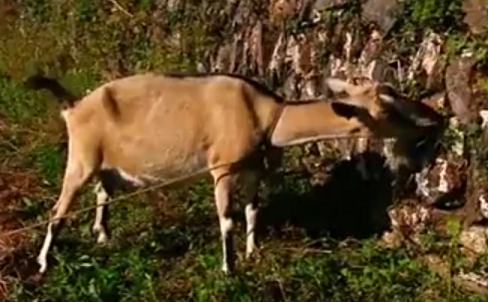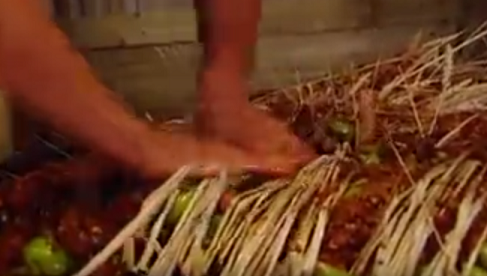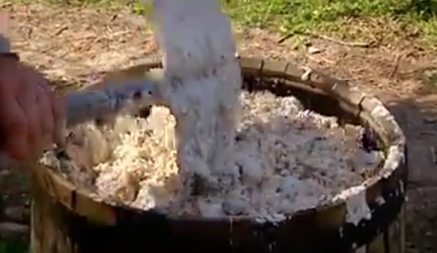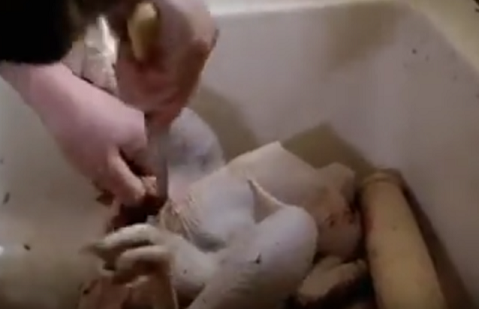If you missed episode 1, you can find the write-up here.
We are now on episode 2 of The Edwardian Farm put out by the BBC. If you have not heard of this show, the idea is that 3 modern people (Alex, Ruth, and Peter) are sent to an abandoned farm from the Edwardian age (early 1900s) and need to live for a year just as those people would have. In the first episode, we were introduced to our characters and they did some pretty amazing things like making quick lime and stacking hay to keep water and rodents off of it. In this episode (seen here), we join the trio back on the farm in Devon. It is October, so that brings new things to the farm.
Lesson 1: Transplanting Strawberry Plants

Strawberry plants send out runners. These runners will eventually become a full-grown plant. However, until they are fully rooted, they still depend on the parent plant for their nutrition. If you try to take out one of the immature runners and plant it elsewhere, you will not be successful. What Ruth and Alex do is dig up the runner, place a little pot underneath it and then place the runner back in the pot with some soil. Later, once the runner has developed good roots, they will come back and cut away the stem connecting it to the mother. This is how you can transfer strawberry plants.
Lesson 2: Clearing Brush on Steep Land or Terraces

Tractors do not do well on steep land or on terraces. In order to clear out the brush, you either need to get in there and do it yourself, or you can use goats. In this episode, they attached the goats to a picket and let them go at the brush on the terraces. They say it works great (but I am dubious about the goats not escaping...).
Lesson 3: Pickling Apples

Yes, you read that correctly - pickling apples. Apparently, this was quite popular in the beginning of the 20th century. They pickled apples pretty much like you would cucumbers although they would add a bit of sugar to the vinegar. Sounds strange to me, but who knows!?!
Lesson 4: Use Straw when Pressing Cider

This is a very fascinating method to press apples for cider. You really need to watch this section of the video (right about the 20:00 mark). They have a HUGE cider press, and it does not have a big bucket to contain the mashed up apples. Instead, they use straw to contain the mash. And even with the huge pressures exerted by the press, the solid part of the apples did not escape. Check it out!
Lesson 5: When Preserving Meats with Salt, Use Different-Sized Crystals

Most people know that you can preserve meat with salt. This was one of the main ways people did it before refrigeration. However, one tip in this video that was interesting was to use grains of salt of different sizes. They say that this will allow the salt to penetrate the meat better - some will be able to go deeper, and some not so deep.
Lesson 6: Making Slaked Lime

In the first episode, Peter and Alex showed us how to make quick lime by heating limestone to 900 degrees. In this episode, they take some of that quick lime and make slaked lime. Slaked lime is a putty that is VERY useful on the homestead. It is used in things like plaster. In order to make it, you simply add water to the quick lime and let it sit. The longer the slaked lime sits, the better it will be. But be careful! When you add water to quick lime, it heats up rapidly - hot enough to even burn wood.
Interesting Thing

Chicken used to be the meat of rich people. It used to take a whole lot more time to grow chickens than is commonly seen on factory farms of modern times - ask anyone who has raised anything other than Cornish cross! However, the extra time paid off in extra flavor. You will never get such a tasty bird in the supermarket!
The Rest of the Episode
The rest of the episode deals with the various traditions of Halloween. If you want to see how Edwardians celebrated that holiday, go ahead and watch the end of the episode.
End of Episode 2
Well, that is all! Did you find anything particularly useful in this episode? Let me know in the comments below!

Nice post! I will follow you from now on. I give you a vote!
Thanks, @dtubix.
I’m so glad I caught this post. I wanted to watch the series after your first post about it, but I didn’t write it down, so I forgot. I’ve written it down this time! Thanks for the reminder.
No problem! So much to learn form all of these episodes - it is amazing!
We have watched all the shows that was put out from BBC on the old farming ways and life that are good. thanks
We have watched most of the other ones. Probably our favorite was Tudor Monastery Farm, but all of them are really enjoyable.
Thanks for the summary. The tips about lime were fascinating.
That was my favorite part, too. Especially since I have lots of plans to use lime in the future with my building projects!
I'd forgotten about the pickling apples part.
And you're right, that cider press was a monster!
I couldn't believe it when I saw it, and then I couldn't believe it when the apple mash didn't squeeze out through the straw with all that pressure on it! Amazing!
I wonder if the hollowness of the straw has anything to do with containing the mash. Ingenious process!